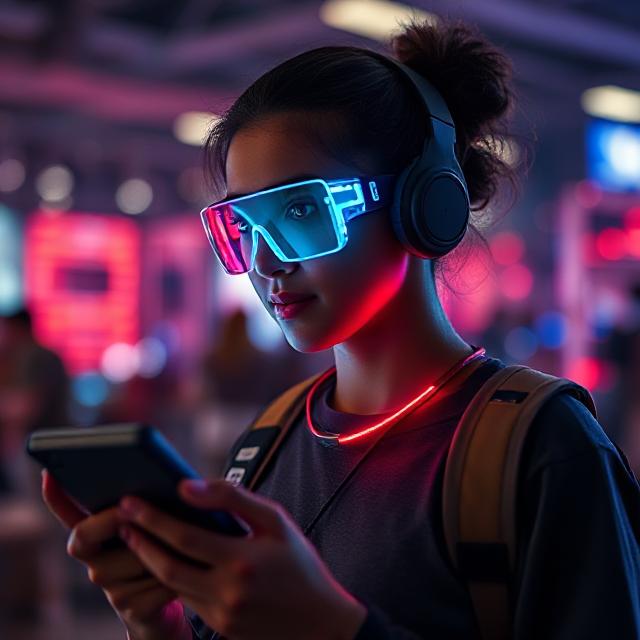Wearable technology is rapidly transforming the educational landscape by enhancing student health, wellness, and focus. Devices such as smartwatches, fitness trackers, smart glasses, and wearable study aids provide real-time data that help students maintain physical and mental well-being while boosting productivity.
Key Benefits of Wearable Tech for Students
-
Health Monitoring: Tracks heart rate, sleep quality, physical activity, and stress levels to promote balanced lifestyles and early detection of health issues.
-
Stress and Mental Health Management: Wearables offer guided breathing exercises, mindfulness support, and stress detection through physiological signals like electrodermal activity and heart rate variability.
-
Sleep Optimization: Devices monitor sleep patterns and suggest improvements, ensuring students get adequate rest for better cognitive function and focus.
-
Physical Fitness Encouragement: Step counting, workout tracking, and posture reminders help students stay active and reduce sedentary behavior.
-
Focus and Distraction Management: Features like “Do Not Disturb” modes, focus timers, and screen time tracking help students minimize distractions during study sessions.
-
Productivity Tools: Smartwatches and wearable planners send reminders for classes, assignments, and exams, while smart pens and digital notebooks facilitate note-taking and organization.
-
Eye and Posture Health: Smart glasses with blue light filtering reduce eye strain, and posture-correcting wearables prevent back pain from long screen hours.
Applications in Education and Health
-
Real-Time Health Alerts: Wearable heart rate monitors can alert teachers or parents to abnormal health readings, enhancing student safety.
-
Focus Monitoring: Specialized headbands measure brain activity to assess and improve student concentration.
-
Chronic Condition Management: Devices like glucose monitors assist students in managing diabetes and other health conditions.
-
Sports and Fitness: Wearables track athletic performance and help prevent injuries by analyzing movement patterns.
-
Audio Learning: Smart earbuds enable students to listen to lectures and audiobooks on the go, supporting diverse learning styles.
Challenges and Future Trends
While wearable tech offers promising benefits, challenges remain such as user acceptance, data privacy, ethical concerns, and the need for more evidence-based validation of health outcomes. Future innovations may include more advanced mental health monitoring, AI-driven personalized learning, and seamless integration with educational platforms.
Practical Tips for Students Using Wearable Tech to Enhance Health and Focus
To maximize the benefits of wearable technology, students can adopt the following strategies:
-
Set Personalized Goals: Use your wearable’s app to define daily step counts, sleep targets, and focus durations tailored to your lifestyle.
-
Regularly Review Health Data: Analyze trends in sleep quality, heart rate, and activity levels to identify patterns affecting your academic performance.
-
Leverage Focus Modes: Activate “Do Not Disturb” or focus timer features during study sessions to minimize interruptions.
-
Incorporate Mindfulness Practices: Use guided breathing and meditation apps available on many wearables to reduce stress and improve mental clarity.
-
Maintain Device Hygiene: Regularly clean and update your devices to ensure accurate readings and avoid skin irritation.
-
Balance Screen Time: Use screen time tracking tools to avoid digital fatigue and schedule breaks for physical movement.
-
Engage in Physical Activity: Follow workout reminders and posture alerts to stay physically active and reduce the risk of musculoskeletal issues.
Real-World Case Studies: Wearable Tech Impact on Student Health and Focus
Case Study 1: University Wellness Program
A major university integrated fitness trackers into its student wellness initiative. Over one semester, students using wearables reported a 20% increase in physical activity and a 15% improvement in sleep quality. Academic advisors noted better concentration and reduced stress levels among participants.
Case Study 2: Focus Enhancement with Neurofeedback Headbands
A high school piloted neurofeedback headbands that monitor brainwaves to help students recognize when their focus wanes. Students trained with these devices showed significant improvements in sustained attention during exams and study sessions.
The Future of Wearable Tech in Education
Looking ahead, wearable technology is poised to become even more integral to student health and academic success:
-
AI-Powered Personalization: Artificial intelligence will tailor health and study recommendations based on individual biometric data and learning habits.
-
Integration with Virtual and Augmented Reality: Wearables will enhance immersive learning experiences while monitoring physical and cognitive states.
-
Advanced Mental Health Monitoring: Future devices will detect early signs of anxiety, depression, and burnout with greater accuracy and provide timely interventions.
-
Seamless Educational Ecosystems: Wearables will sync effortlessly with school management systems, enabling real-time feedback for teachers and personalized support for students.
-
Sustainability and Accessibility: Innovations will focus on eco-friendly materials and affordability to ensure all students benefit from wearable technologies.
Conclusion
Wearable technology represents a powerful tool to support student health, focus, and overall well-being. By offering real-time insights and actionable feedback, these devices empower students to take control of their physical and mental health, leading to improved academic performance and a balanced lifestyle. As technology advances, the integration of wearables in education will deepen, fostering healthier, more focused, and engaged learners.
